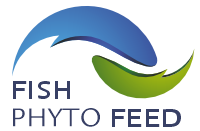Alternative protein sources of low ecological footprint and at affordable prices for fish feed formulation are key to the sustainable development of aquaculture. Nevertheless, they often impact fish physiology and metabolism due to the presence of various endogenous antinutritional factors and phytoestrogens. The demonstrated negative effect of phytoestrogens on white muscle development and growth highlights the need for tools to screen for potential myostatic action of raw materials and fish feeds. This study combines different approaches to validate white muscle gene markers (Georgiou et al., 2016, Cell Tissue Res 363, 541) in the gilthead seabream, Sparus aurata L., as indicators of compromised myogenesis when fed alternative protein sources.
Three diets were formulated – a soy-free diet (C), a 20% soybean meal diet (SBM), and a 20% soy protein concentrate diet (SPC) – and they were fed to triplicate groups of seabream of 27g average initial BW for three months. The expression levels of mylpfa (myosin light chain phosphorylatable, fast skeletal muscle a, associated with hypertrophy), mylpfb (associated with hyperplasia), and myog (myogenin) in white muscle were determined at the end of the experiment using Real time PCR. In a second approach, extracts of the diets were applied in primary cultures of myogenic progenitor cells from seabream for three different exposure times following the onset of differentiation. Cells were collected at the end of the exposure and the same marker genes were measured. In teleosts, muscle growth occurs through hyperplasia, which involves the recruitment of new muscle fibers, and hypertrophy, which involves a size enlargement of existing muscle fibers. The effects of SBM and SPC on hyperplasia and hypertrophy in the feeding trial were consistent with the effects recorded in vitro. Hyperplasia as marked by mylpfb expression was significantly reduced in fish fed on SBM and SPC, whereas hypertrophy as marked by mylpfa expression was significantly reduced only in fish fed on SBM. Myogenin expression remained unaffected. Similar results were recorded in primary cell cultures after 48h of exposure to diet extracts; both SBM and SPC were potent in downregulating mylpfb expression, whereas mylpfa expression was significantly affected only in the presence of SBM extract. To our knowledge this is the first study to demonstrate that primary cultures of myogenic progenitor cells can be used as a screening tool for potential myostatic action of fish feeds containing alternative protein sources. The validated protocol developed is time- and cost-effective while complying with the 3Rs principle.
Acknowledgement: This research has been co-financed by the European Union and Greek national funds through the Operational Program Competitiveness, Entrepreneurship, and Innovation, under the call SPECIAL ACTION AQUACULTURE, Project title “ FishPhytoFeed- Development of an Advanced Integrated Toolbox for in vitro high-throughput screening of quality and phyto-estrogens in feed ingredients for Mediterranean finfish“.



